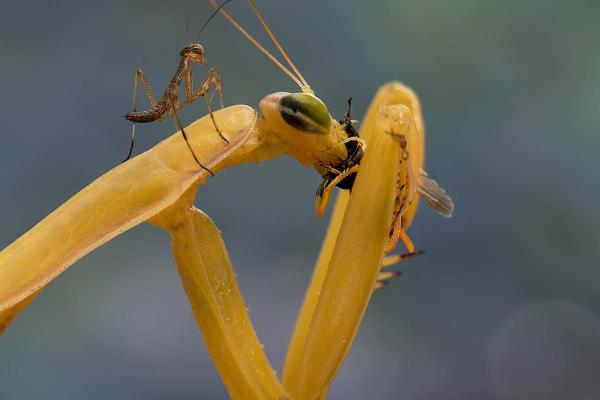What Do Praying Mantises Eat?


Praying mantises are some of the most fascinating and unique predators in the world. With their powerful front legs, camouflaged bodies, and lightning-fast reflexes, they are perfectly adapted to catching and eating a wide variety of prey. But what exactly do praying mantises eat, and how do they hunt?
In this article, we will explore the praying mantis diet in detail. We will discuss the different types of prey that mantises eat, how they hunt, and why they are such important members of the ecosystem.
Type of feeding of the praying mantis
Praying mantises are carnivores, meaning they eat other animals.
They are also generalist predators, meaning they eat a variety of different prey items. The type of food that a praying mantis eats will vary depending on its size, age, and availability of prey.
Praying mantises are ambush predators, meaning they wait for their prey to come to them. They have excellent vision and hearing, which helps them to detect prey from a distance. Once they have spotted their prey, they will quickly strike with their powerful forelegs.
These insects are also able to capture prey that is larger than them. They do this by using their forelegs to pin the prey down and then biting it with their sharp mandibles.
Praying mantises are important predators in the ecosystem that help to control populations of insects and other invertebrates. They are also a food source for other animals, such as birds and snakes.
Learn about other carnivorous animals and their adaptations for hunting.
What do baby praying mantises eat?
Newborn praying mantises, also called nymphs, have a similar diet to adults, but their size and hunting skills are limited. As they grow and develop, they can tackle larger prey.
Some common prey items for baby praying mantises include:
- Aphids
- Fruit flies
- Leafhoppers
- Small crickets
- Small spiders
- Small caterpillars
- Other small insects
As nymphs shed their exoskeletons and increase in size, they become more effective hunters. Their diet expands to include larger insects such as medium-sized flies, grasshoppers, and other insects appropriate to their developing size.
How to feed a baby praying mantis
Baby praying mantises are very hungry and need to eat frequently. You can feed your baby mantis every 1-3 days, depending on its size and age. Be sure to remove uneaten prey from the mantis's enclosure after 24 hours.
As the mantis grows, you can start to feed it larger prey items. However, it is important to make sure that the prey is never larger than the mantis's head.
Here are some tips for feeding baby praying mantises:
- Offer your mantis a variety of prey items to choose from. This will help ensure that it is getting a balanced diet.
- Dust the prey items with a calcium powder before feeding them to your mantis. This will help to prevent the mantis from developing calcium deficiency.
- Make sure that the prey items are alive before feeding them to your mantis. Dead insects are not nutritious and can be difficult for the mantis to digest.
- Remove uneaten prey from the mantis's enclosure after 24 hours.
With proper care and feeding, your baby praying mantis will grow into a healthy and thriving adult.

What do adult praying mantises eat?
Adult praying mantises are voracious predators and have a very diverse diet. They can eat a wide variety of animals, including:
- Other Insects: they commonly prey on flies, moths, mosquitoes, crickets, grasshoppers, and beetles, among others.
- Small arthropods: in addition to insects, adult mantises may also consume smaller arthropods such as spiders and small crustaceans if the opportunity arises.
- Occasional vertebrates: while it is less common, some larger species of mantises have been known to capture and feed on small vertebrates like frogs, lizards, and even small birds.
- Nectar and pollen: While most mantis species are carnivorous, some tropical species, such as the orchid mantis (Hymenopus coronatus), are known to consume nectar and pollen from flowers. This behavior provides them with additional nutrients and is an adaptation to their specific environment.
If you are keeping praying mantises as pets, it is important to provide them with a variety of insects to eat. You can purchase live insects from pet stores or online retailers, or you can catch insects yourself. Be sure to identify any insects you catch correctly before feeding them to your mantis, as some insects can be harmful.
To feed your praying mantis, simply drop the live insect into its enclosure. The mantis will then hunt and eat the insect.
Do praying mantises eat their mates?
Sexual cannibalism in praying mantises is a fascinating and complex phenomenon. It is a relatively rare event, but it has been observed in a number of different praying mantis species.
There are a number of reasons why a female praying mantis might eat her mate. In some cases, it may be a way for her to get extra nutrients to support her eggs. It may also be a way for her to prevent the male from mating with other females.
Discover the fascinating and complex relationship between sexual cannibalism and praying mantis reproduction.

How do praying mantises hunt?
Praying mantises are skilled hunters that employ several techniques to capture prey. They are remarkable predators with a combination of stealth, patience, and precise striking abilities that make them highly effective hunters in a variety of environments.
Praying mantises are ambush predators. This means they patiently wait for their prey to come within striking distance. They typically sit motionless and blend into their surroundings, using their excellent camouflage to hide among leaves or on branches.
Some mantis species have developed luring behaviors. For example, the orchid mantis (Hymenopus coronatus) resembles a flower and sits on orchid blossoms to attract pollinators and other insects. When prey approaches, it becomes the target of the mantis's quick strike.
Mantises have a body structure that resembles leaves or twigs, depending on their habitat. This camouflage helps them remain inconspicuous to potential prey and predators alike.
When prey comes within reach, mantises use their powerful, raptorial forelimbs (the "praying" posture) to strike quickly. Their forelimbs are equipped with sharp spines and are capable of delivering a precise and rapid strike to grasp and immobilize prey.
Mantises use a combination of visual acuity and motion detection to locate prey. They have large, compound eyes that provide them with excellent vision. They can rotate their heads nearly 180 degrees, allowing them to scan their surroundings for potential prey. They are particularly adept at detecting small, flying insects.
After capturing prey, mantises often clean their forelimbs by meticulously removing any debris or venom from their spines to prepare for future hunts.
Praying mantises are amazing creatures, but are they poisonous? Read all about it in this other article.
If you want to read similar articles to What Do Praying Mantises Eat?, we recommend you visit our Facts about the animal kingdom category.
- Birkhead, T. R., Lee, K. E., & Young, P. (1988). Sexual cannibalism in the praying mantis Hierodula gallinacea . Behavior, 112-118.
- Lelito, J.P., & Brown, W.D. (2008). Mate attraction by females in a sexually cannibalistic praying mantis . Behavioral Ecology and Sociobiology, 63, 313-320.
- Maldonado, H., Levin, L., & Pita, JB (1967). Hit distance and the predatory strike of the praying mantis . Zeitschrift für vergleichende Physiologie, 56, 237-257.
- Rankin, EEW, Knowlton, JL, Shmerling, AJ, & Hoey-Chamberlain, R. (2023). Diets of two non-native praying mantids (Tenodera sinensis and Mantis divino) show consumption of arthropods across all ecological roles . Food Webs, 35, e00280.







